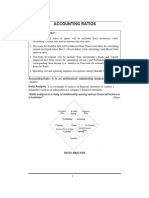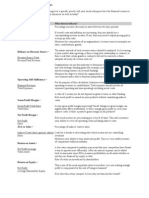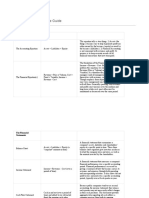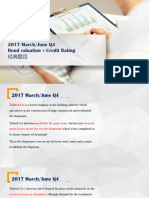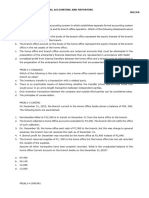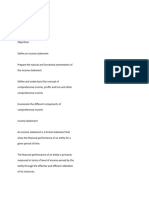Notes on Ratios
IMPORTANT
The ratios and formulae discussed in this note for the purpose of this trimester only. As you go into
later trimesters, we may have to modify the definitions and formulae. The focus in this trimester is
to enable you to understand the basic concepts.
The following are only a quick guide to the topics discussed in class. Please refer to text books for
more detailed discussions.
Profitability Ratios
Profit / Sales
What should be the numerator? It depends on the purpose and the person.
If we want to know how much profit is being made purely at the manufacturing level, not taking into
account marketing and other expenses, we would take GROSS PROFIT
If we want to know how much profit the business is making as a whole, we will take NET PROFIT.
If we want to know how much operating profit is being made i.e. profit from operations, we will take
OPERATING PROFIT.
What is the difference between gross profit, net profit and operating profit?
For gross profit, we consider sales income less manufacturing expenses i.e. we consider only those
expenses relating to manufacturing of the product like raw material cost, labour cost, electricity
expenses at factory, depreciation of machinery and such similar expenses. We exclude expenses on
marketing, general administration, head office expenses etc.
For net profit, we consider total income (sales income and other income) less all expenses
For operating profit, we consider sales income less all operating expenses – we do not include
interest as operating expenses.
Why do we not consider other income above?
Because other income is not from operations
What do we mean by operating expenses?
All expenses of the business that are required for the operations.
What about EBITDA etc?
In these cases, we consider profit at the appropriate level. (eg) EBITDA is earnings (profit) before
charging interest, tax, depreciation and amortization.
The term operating profit is a bit confusing.
We need to see the context and use it. WE CAN SAY THAT OPERATING PROFIT IS PROFIT FROM
OPERATIONS – so we exclude other income and interest.
�In the case of banks and finance companies, their core business is borrowing and lending. In such
cases, interest is a part of the operating expense. So, in these cases, it is not correct to exclude
interest from expenses.
That’s why you need to look at the context and then decide on operating profit.
Gross Profit > Net Profit
Operating Profit > Net Profit (Why?)
Sometimes, a business may sell an asset such as land or buildings. Profit from sale of such asset may
be shown in the profit & loss account as income. Should this be included while calculating
profitability ratios? NO. Because these are not part of regular operations but exceptional items.
BUT, in a company that constructs and sells buildings, sale of buildings is a core income. Here, you
cannot exclude that income because that is the business of the company
Return on Equity
Return on Assets
Return on Capital Employed (or Return on Investment)
The above ratios measure the profit in relation to equity owned by shareholders or value of assets
used in business or value of equity and debt used in the business
Numerator is always profit. It is best to take PAT. You may take PBT if you want to measure return
purely on manufacturing activities.
Return on Equity
PAT / (EQUITY SHARE CAPITAL + RESERVES & SURPLUS)
Return on Assets
PAT / (AVERAGE ASETS VALUE)
Preferable to take fixed assets
Return on Capital Employed
Capital Employed = total of equity share capital, reserves & surplus and debt (long term and short
term)
PAT / CAPITAL EMPLOYED
Except average assets, other two denominators are taken as at the end of the period.
If you remember the balance sheet structure, the fixed assets are funded by equity and debt. So, we
use both return on equity and return on capital employed. We DON’T use return on debt
�Leverage Ratios
Essentially we are considering Debt Equity Ratio
When we have borrowings in a company, the company is said to be levered i.e. leveraging on equity
or taking advantage of equity.
Debt includes all borrowings – long term and short term. It does not include current liabilities like
payables to vendors etc.
Debt means borrowings.
Equity means equity share capital and reserves & surplus i.e. all money belonging to the
shareholders.
Is there an ideal debt equity ratio?
No. There is no ideal debt equity ratio. Depending on the industry, the ratio will vary. For
manufacturing companies, a ratio less than 1 : 1 or upto say 1.5:1 is considered to be comfortable.
For a bank or finance company the ratio will be much higher – even 4 : 1 or 5 : 1 because banks and
finance companies are dependent on borrowings for their business.
Turnover Ratios
We have
Asset turnover ratio and inventory turnover ratio
Asset Turnover Ratio
What are assets?
Ideally we should look at long term or fixed assets. This is for two reasons. (1) Current assets are
generally much lower in value than fixed assets. (2) we are considering assets that generate
production or business.
Should we take value of assets at the beginning of the year or end of the year or average of the
assets values at the beginning and at the end?
We should ideally take average value of the assets.
And numerator?
This will be the sales value. Don’t take total income.
Higher the asset turnover ratio, it means that the business is utilising its assets better. Remember
the example of the cab operator discussed in class.
Inventory Turnover Ratio
Similar to asset turnover ratio, this ratio measures how well the business is utilising its inventory.
Higher the ratio, it means the business is utilising its inventory better i.e. it buys raw materials,
converts them into finished products and sells them fast.
�Denominator : Average inventory (average of inventory value at beginning and end of year)
What do you mean by inventory?
Inventory includes all materials like raw materials and finished goods.
Numerator :
We consider Cost of Goods Sold. We DO NOT TAKE sales. But sometimes we use sales because COGS
is not available.
What is COGS?
It is the cost of raw materials + labour cost + cost of manufacturing or expenses you consider for
calculating gross profit.
Why use COGS and not Sales?
Sales has an element of profit and can distort the ratio. Whereas, COGS does not have this profit
element and we are comparing cost of inventory with cost of goods sold.
Liquidity Ratios
Current Ratio
Current assets to current liabilities
What are current assets?
Any asset that will be converted into cash within a year or cash or bank balance.
(eg) inventory of finished goods will be sold within a short time
(eg) receivables from customers – the amount will be received within a short period
What are current liabilities?
Any liability that will be paid off within a year.
(eg) payable to suppliers of materials
Is there an ideal ratio for current ratio?
No. Ideally current ratio should be more than 1 : 1 so that current liabilities can be paid off using
current assets. If the ratio is less than 1 : 1, the business will have to borrow to pay off its current
liabilities.
Quick Ratio
All current assets cannot be converted into cash quickly to pay the current liabilities. (eg) it may not
be possible to sell inventory quickly when the business wants. Hence, value of inventory is removed
from the value of current assets to calculate the quick ratio.
Quick ratio = (value of current assets less value of inventory) / value of current liabilities
There is no ideal ratio for quick ratio also but it would be good if the ratio is more than 1 : 1 for the
same reasons as the current ratio.




































